Losing Rosario A mother sent her daughter across the border Before they could reunite one died
Black feathers fell from circling vultures and snagged in the matted yellow grass. The ranch manager eyed the terrain and followed the stench. He found the woman’s body, like so many others in the south Texas brush: splayed in the weeds, arms dark with decay, raised above her head as if in surrender.
The rancher knew what to do. He had come upon 15 such migrants over the years. He called Brooks County sheriff’s dispatchers. They issued a Code 500, a dead body call, summoning a deputy, two Border Patrol agents, a justice of the peace and a funeral director.
They met the rancher shortly before noon at the gate of Los Palos Ranch, about 75 miles north of the border. Together they waded through knee-high, thorny weeds, mindful that the June heat rouses rattlesnakes from their burrows. The men gazed down to where she lay â€" face gone, skull picked clean by scavengers, hair and lower jaw dragged a few feet from a body not yet skeletal.
They guessed the woman had died of exhaustion or dehydration.
“They wait over there and move at night,†said the rancher, pointing to a nearby stand of mesquite, where he and his wife sometimes spy the passing shadows of those heading north.
The deputy wrapped the body in a white sheet. He then lifted it into a gray bag and helped the funeral director load it into the back of his Ford Explorer for transport to the sheriff’s morgue. It would be fingerprinted and tested for the coronavirus. The men found no trace of a name. It would be days before fingerprints told investigators that the woman was Rosario Yanira Girón de Orellana, a 41-year-old single mother who had traveled more than 1,500 miles from El Salvador.
× VIDEO | 02:23 Losing Rosario: A mother dies crossing the border before reuniting with her daughterAuthorities transport the body of Rosario Yanira Giron de Orellana, a 41-year-old migrant from El Salvador who died before she could be reunited with her 15-year-old daughter. Her body was found on a ranch in Falfurrias, Texas.
Brooks County and the Rio Grande Valley to the south have been popular smuggling routes for decades, a reliable barometer of migrant deaths borderwide. Six months into 2021, deaths in the county had already reached 55, up from a total of 34 last year and above the five-year average. Migrants here often dial 911 from their cellphones, stranded without water and begging for help. Some days this summer, officials recovered three bodies. All were adults, more than half male. Their identification was from Central America or Mexico. Relatives searching for missing migrants this summer have flown in from as far as California and New York.
Column One
A showcase for compelling storytelling from the Los Angeles Times.
More storiesUnlike the Arizona desert, another migrant deathtrap, south Texas ranchland at first glance appears verdant. But it’s a deadly mirage. Temperatures climb to nearly 100 degrees. Of the county’s 944 square miles, about twice the size of the city of Los Angeles, only a fraction of a square mile has water. Los Palos and other ranches have cattle troughs and tanks, but they’re teeming with bacteria, and migrants who drink from them have died. Those who don’t succumb to the elements are sometimes abandoned by smugglers.
Agents and deputies do what they can to patrol suspected smuggler drop-off and pickup spots, including County Road 107, the road closest to where Rosario’s body was found, a milelong stretch of caliche that dead-ends at Los Palos Ranch. Migrant advocates have placed more than 150 blue barrels of water on CR 107 and other local highways. But Rosario was discovered miles from the road, beyond sight of the barrels.
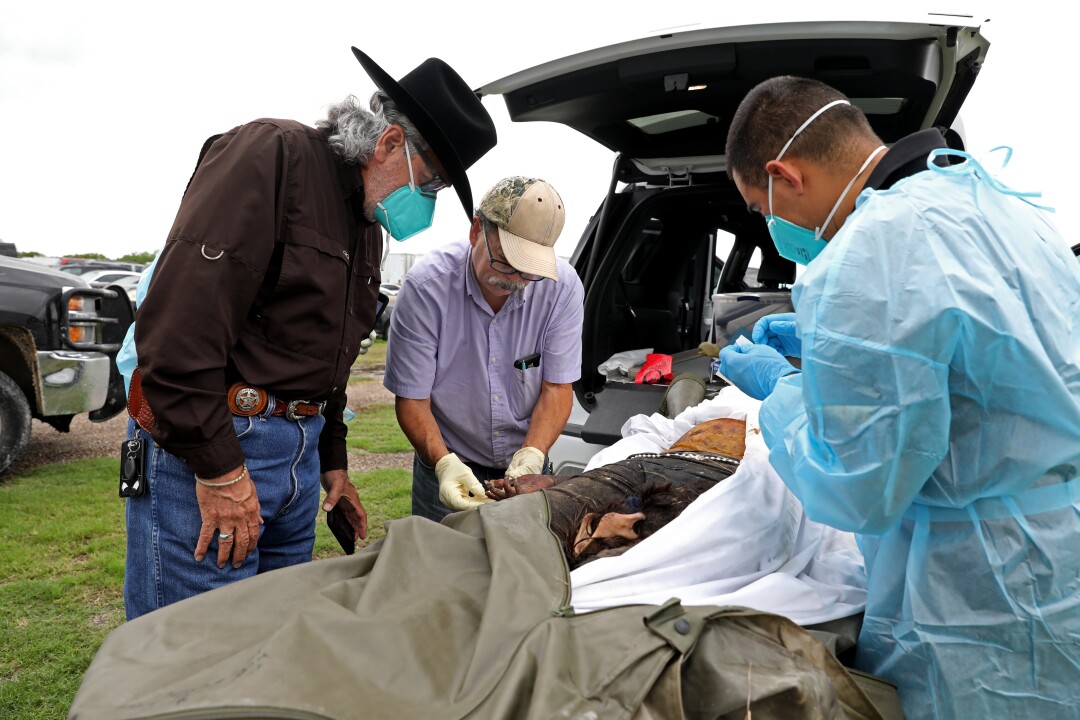 From left, Brooks County Sheriff Urbino “Benny†Martinez; Alonzo Rangel, funeral director of Funeraria Del Angel; and John Gomez, a sheriff’s investigator, prepare to photograph the body’s fingerprints for identification.(Gary Coronado / Los Angeles Times)
From left, Brooks County Sheriff Urbino “Benny†Martinez; Alonzo Rangel, funeral director of Funeraria Del Angel; and John Gomez, a sheriff’s investigator, prepare to photograph the body’s fingerprints for identification.(Gary Coronado / Los Angeles Times) 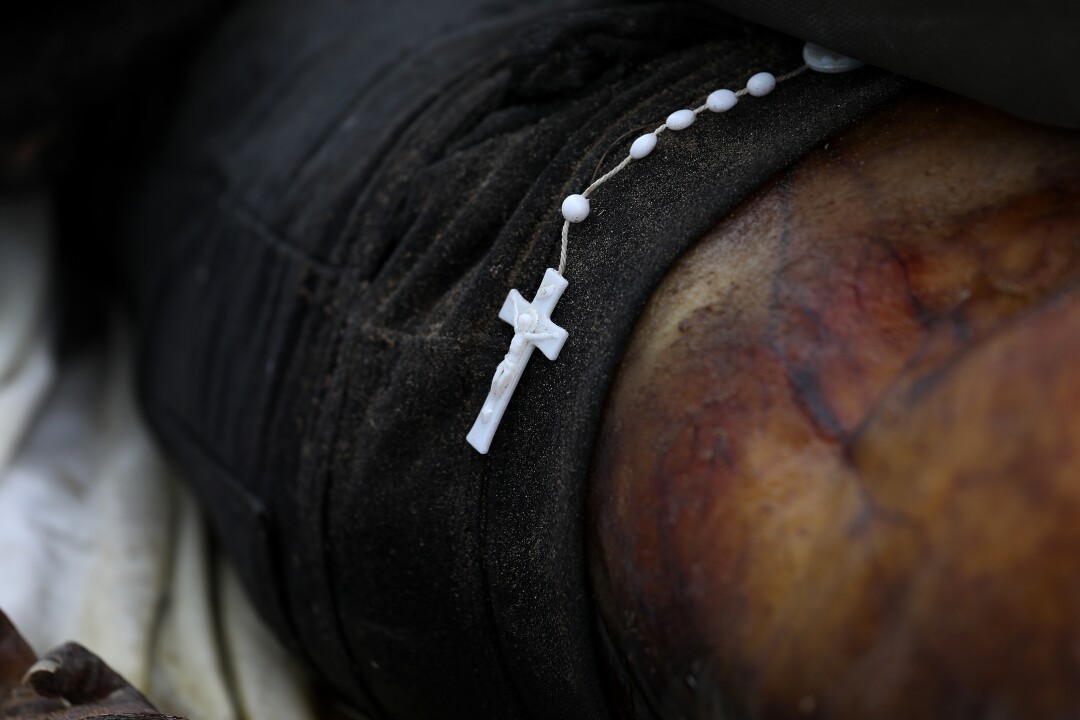 A rosary found with the body of Salvadoran migrant Rosario Yanira Girón de Orellana drapes her waist.(Gary Coronado / Los Angeles Times)
A rosary found with the body of Salvadoran migrant Rosario Yanira Girón de Orellana drapes her waist.(Gary Coronado / Los Angeles Times) She had been found without a purse, phone, passport or other identification. Her black hair was cinched in a blue scrunchie. Her black striped shirt was pulled up to reveal a pink lace bra above black pants. Smugglers often instruct migrants to dress in black â€" good camouflage at night but brutally hot after sunrise.
The deputy checked her pockets: nothing. She wore no jewelry, just a plastic rosary and a string of rainbow beads with a medallion that said, in Spanish, “Virgin, please guide my path.â€
“What is the time?†asked one of the Border Patrol agents.
It was 12:16 p.m. The justice of the peace pronounced Rosario dead. Once the funeral director drove the body to the morgue, agents photographed her blackened fingers, hoping to identify prints. They sent a picture of her left thumbprint to the Salvadoran Consulate. A match came back the next day.
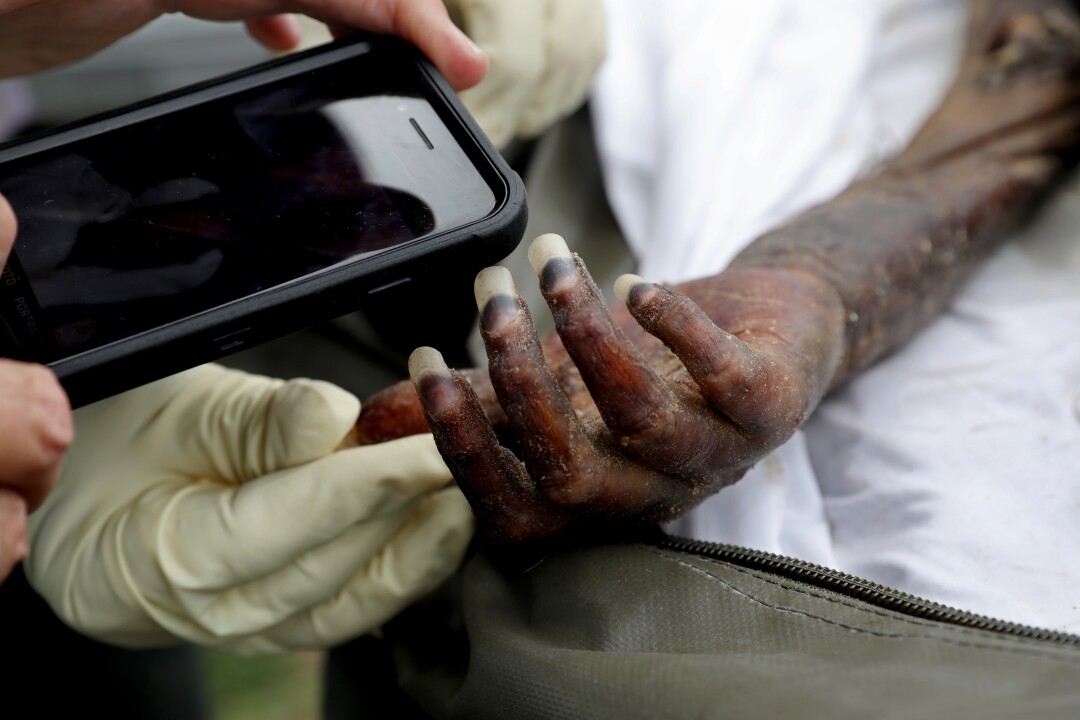 Brooks County Sheriff Urbino “Benny†Martinez photographs the fingerprints, which were sent to the Salvadoran consulate and used to identify Rosario Yanira Girón de Orellana.(Gary Coronado / Los Angeles Times)
Brooks County Sheriff Urbino “Benny†Martinez photographs the fingerprints, which were sent to the Salvadoran consulate and used to identify Rosario Yanira Girón de Orellana.(Gary Coronado / Los Angeles Times) The daughter of a farmworker, Rosario grew up in the coastal town of San Julián, population 22,000, about 40 miles west of the capital. She was slender, shorter than 5 feet tall, the second of nine siblings, some of whom described her as a second mother, a homebody they nicknamed “Chaito.â€
Devout but headstrong, Rosario celebrated her quinceañera not with a party but by reciting the rosary with friends and family at home. She loved her namesake roses but rarely received them. Married at 21, she had a daughter, Adriana Orellana de Girón, then in recent years she separated from her husband and moved back home. Rosario seldom went out; she mainly went to church, where she taught catechism classes.
Rosario raised not only her daughter but her siblings, nieces and nephews. She took them to school, church and a local park, helped with their homework and put them to bed. She watched most of them depart for the U.S. and settle where her father had before he was deported 11 years earlier: Houston.
Rosario never spoke of migrating. But in November, she celebrated her daughter’s quinceañera, buying her a sleeveless aqua dress and speaking eloquently about her passage into womanhood. Privately, her sisters said, Rosario worried that Adriana had grown old enough to be targeted by gangs that ruled the neighborhood.
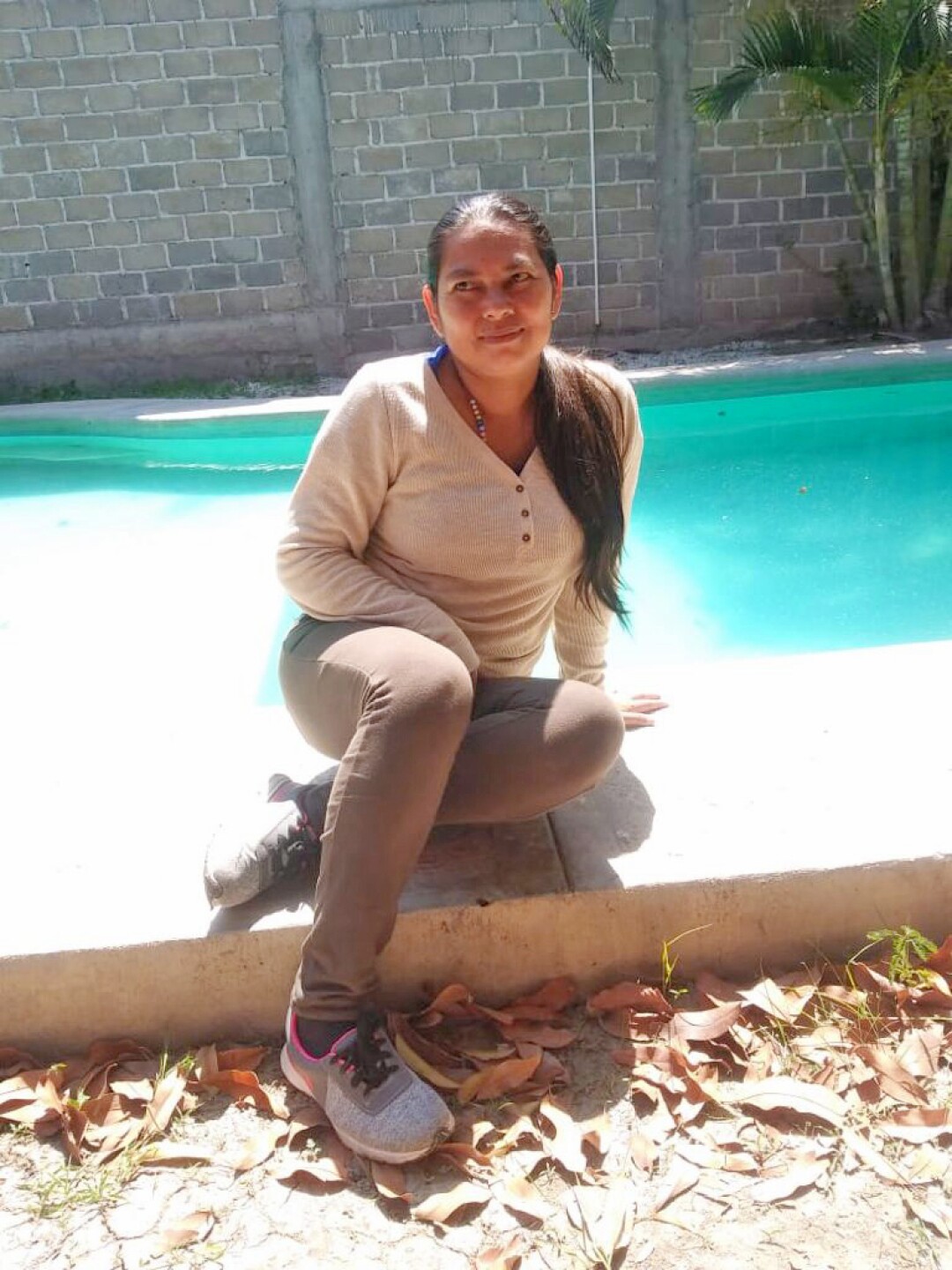 A photo taken in El Salvador of Rosario Yanira Girón de Orellana before she left with daughter Adriana Orellana de Girón, 15, for the United States. A ranch manager discovered Rosario’s body June 4 in South Texas.(Maria Huezo)
A photo taken in El Salvador of Rosario Yanira Girón de Orellana before she left with daughter Adriana Orellana de Girón, 15, for the United States. A ranch manager discovered Rosario’s body June 4 in South Texas.(Maria Huezo) “When she would call me, I would tell her the life is very different here,†recalled Rosario’s older sister Maria Huezo, 42, whose daughter, also named Adriana, will celebrate her quinceañera in the fall. “Here there is work, but you have no time for your kids. There you are with your kids, but there is no work.â€
Huezo had crossed the border illegally about 20 years earlier. She didn’t feel she had the right to tell anyone else not to come. But none of the family had traveled north on foot; they had all been caught soon after crossing the Rio Grande. And none had arrived since President Trump was elected and cracked down on asylum seekers.
“I never imagined Rosario would come,†Huezo said. “To decide to take this path, you have to be brave. And she never went out of the house. She didn’t know how to defend herself in the street, in the world.â€
World & Nation
The things migrants carried â€" and dropped â€" as they crossed the border
Wet sweatshirts. Toddler shoes. A line of Scripture. These are some of the things left behind by migrants making their way across the Rio Grande.
On March 16, about 6 a.m., Rosario said goodbye to her mother and caught a ride with her daughter north. It would take them 15 days, moving from town to town, before they reached the Mexican border city of Reynosa.
Rosario knew from talking to other migrants that if she crossed the border with Adriana, the Border Patrol would send them back to Mexico due to pandemic restrictions. But if Adriana went without an adult, she would be released to relatives in Houston.
Rosario’s younger sister Vilma Girón, 38, had made the same journey in 2014. She was detained by the Border Patrol, released after a few months and sent for her two daughters. They all claimed asylum. The 17-year-old was entering seventh grade; the 21-year-old had graduated high school and was working at an Amazon warehouse, where she would soon qualify for tuition assistance to study at the University of Houston.
 Nancy Balogh, left, and Jerry Passement of U.S. Customs and Border Protection photograph the body before placing it in a portable morgue June 4 outside the Brooks County Sheriff’s Office in Falfurrias, Texas.(Gary Coronado / Los Angeles Times)
Nancy Balogh, left, and Jerry Passement of U.S. Customs and Border Protection photograph the body before placing it in a portable morgue June 4 outside the Brooks County Sheriff’s Office in Falfurrias, Texas.(Gary Coronado / Los Angeles Times) “That is why she came,†Girón said of Rosario over a recent breakfast of pupusas. “That is why we all did it: for our children. We never thought this would happen to us. Where we live, there are so many families who have come, all of them.â€
Rosario didn’t tell her daughter that she was sending her across the border alone until they parted on April 2. She arranged for a fellow migrant mother traveling with the group to pick Adriana up. When the woman arrived, Rosario took the girl aside.
“We have to separate,†Adriana recalled her mother saying. “It’s better for you. We will reunite. God bless and keep you.â€
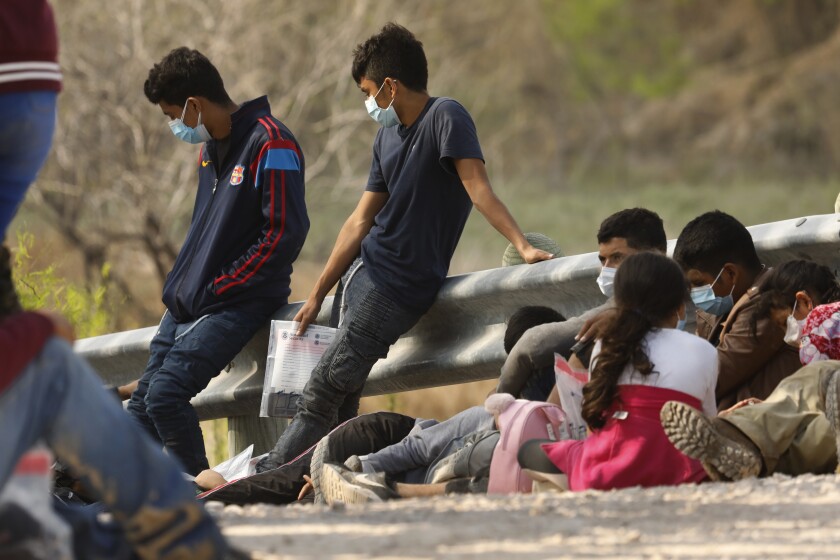
Politics
Biden promised change at the border. He’s kept Trump’s Title 42 policy to close it and cut off asylum
The Biden administration says migrants can still get protection under a Trump-era pandemic policy. But in a year, fewer than 1% have been able to do so.
There would be about 10 migrants in their group, all eligible to enter the U.S. because they were either mothers with young children or youths like Adriana without their parents. Thin, shy and small for her age, Adriana didn’t know how to swim. But she followed the other migrants onto an inflated raft and across the Rio Grande. They were soon detained by the Border Patrol.
Adriana was held for several weeks, then was released to her family in Houston with permission to stay until her asylum case was decided. (Due to a court backlog, her first hearing isn’t until Jan. 12.)
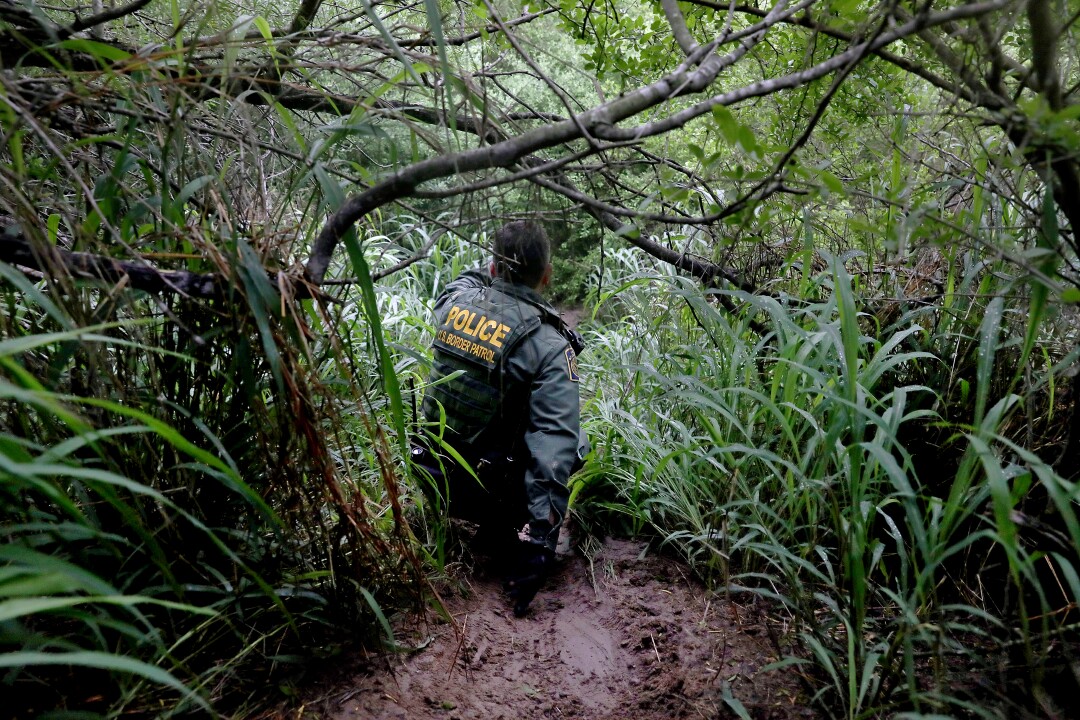 Jesse Moreno of U.S. Customs and Border Protection searches for migrants in Mission, Texas. (Gary Coronado / Los Angeles Times)
Jesse Moreno of U.S. Customs and Border Protection searches for migrants in Mission, Texas. (Gary Coronado / Los Angeles Times) Meanwhile, Rosario had crossed the border to a smuggler’s stash house in the Rio Grande Valley, where she stayed for a couple of weeks before heading with a group to Houston. She had a Salvadoran cellphone and sent WhatsApp messages to her daughter via her brother in San Julián.
“Don’t worry daughter, we are good,†she wrote at 8 p.m. May 26. “We walked two days and two nights and we are in a place where we can rest.â€
Then the messages suddenly stopped.
That scared Rosario’s six siblings in the U.S. None had been incommunicado during their journeys north, unless they were detained by the Border Patrol. Her younger brother, whose asylum case was pending, contacted his immigration attorney, who searched unsuccessfully for Rosario at immigration detention and hospitals.
Days later, Rosario’s sister Vilma Girón started receiving WhatsApp messages from a stranger with a Salvadoran number who claimed to have migrated with Rosario. “Oscar C†said that when Rosario stopped walking on a ranch May 29, fellow migrants left her behind with water and a cellphone.
“He said she was tired, but her health seemed OK,†Girón said. “She was waiting there for immigration to find her.â€
Another man contacted her brother in El Salvador to say Rosario’s group had left a second feverish woman behind who was later rescued by the Border Patrol.
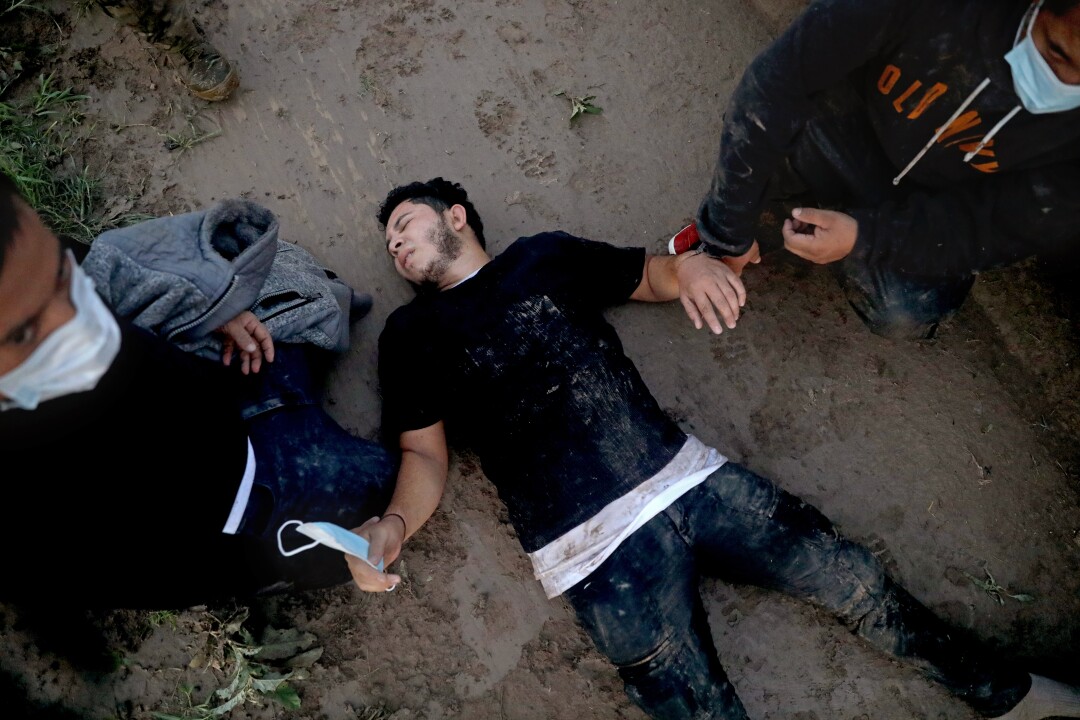 Oney Figueroa, 22, of Honduras, collapses from exhaustion after trying to run from U.S. Customs and Border Protection agents. He and Eduardo Mejia, 34, left, and Antonio Herrera, 42, also of Honduras, were caught by the Border Patrol in the Rio Grande Valley after crossing the border illegally. (Gary Coronado / Los Angeles Times)
Oney Figueroa, 22, of Honduras, collapses from exhaustion after trying to run from U.S. Customs and Border Protection agents. He and Eduardo Mejia, 34, left, and Antonio Herrera, 42, also of Honduras, were caught by the Border Patrol in the Rio Grande Valley after crossing the border illegally. (Gary Coronado / Los Angeles Times) 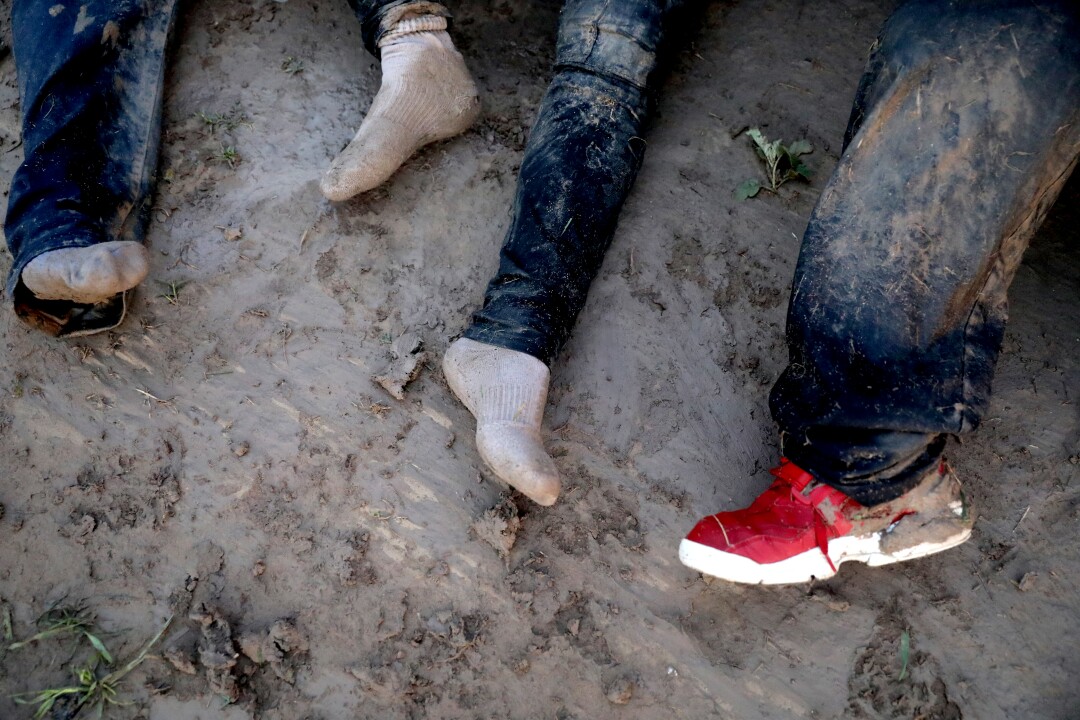 Migrants lost their shoes while being pursued by the U.S. Customs and Border Protection in McAllen, Texas.(Gary Coronado / Los Angeles Times)
Migrants lost their shoes while being pursued by the U.S. Customs and Border Protection in McAllen, Texas.(Gary Coronado / Los Angeles Times) Rosario’s relatives were initially afraid to contact U.S. authorities, because many of them had entered the country illegally. Instead, they phoned the Brooks County-based South Texas Human Rights Center, which distributes the water barrels and fields calls from families searching for missing migrants. Volunteers agreed to help them search and relayed information to the Border Patrol.
One of Rosario’s brothers and a nephew, Huezo’s son â€" both of whom were in the country legally â€" traveled from Houston to Brooks County to search for her June 3.
Huezo texted Oscar for more information, and he responded that Rosario was “at the edge of a sandy street in front of a ranch.â€
“What did she have with her?†Huezo asked.
Her documents and her phone, Oscar said, noting that the phone was turned off, “so that it had a battery.â€
“I have a lot of faith in God that everything will be good with her,†he wrote.
The next day Oscar sent Huezo a Google Maps location for Rosario. She forwarded the coordinates to her son in Brooks County. He and his uncle got within two miles of where Rosario’s body was later found but were stopped by a locked ranch gate. Nearby, they saw discarded shoes and water jugs.
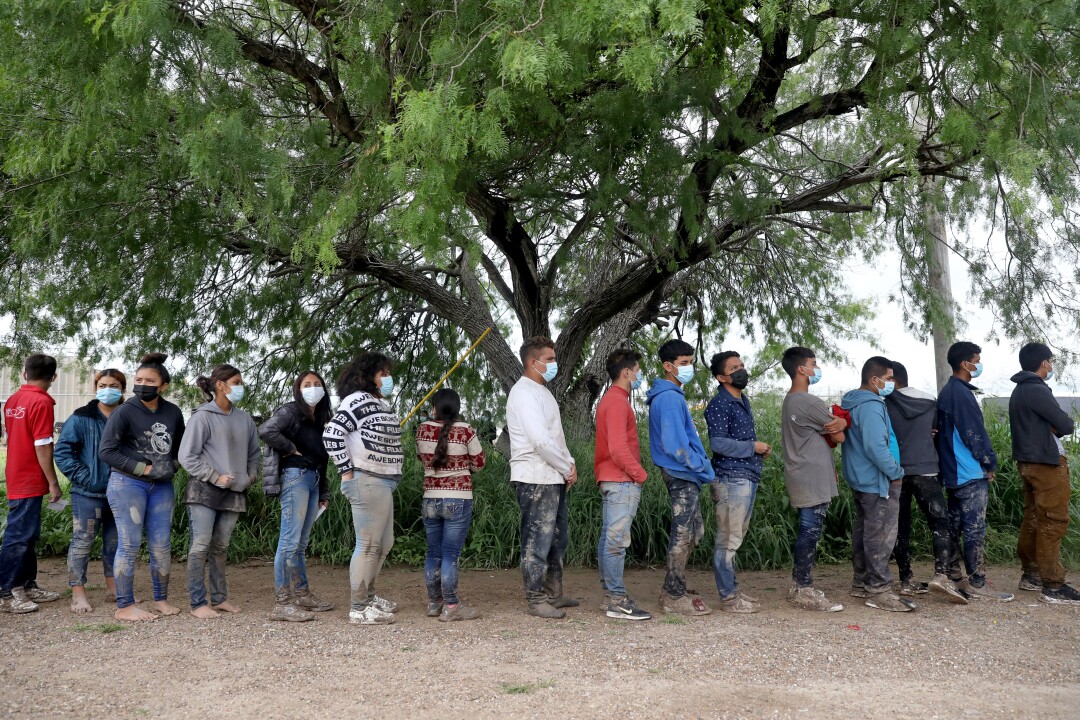 Migrants who crossed the border illegally wait to board a bus to be processed by U.S. Customs and Border Protection in Texas’ Rio Grande Valley.(Gary Coronado / Los Angeles Times)
Migrants who crossed the border illegally wait to board a bus to be processed by U.S. Customs and Border Protection in Texas’ Rio Grande Valley.(Gary Coronado / Los Angeles Times) 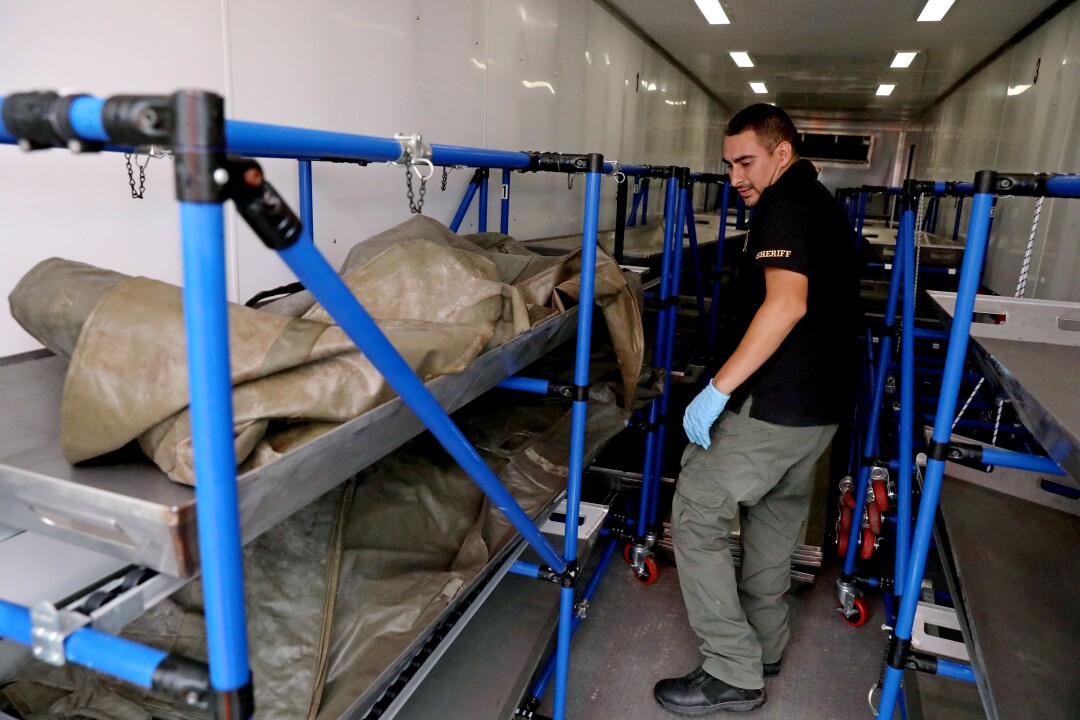 John Gomez, a Brooks County sheriff’s investigator, stores the body of Rosario Yanira Girón de Orellana in a temporary morgue.(Gary Coronado / Los Angeles Times)
John Gomez, a Brooks County sheriff’s investigator, stores the body of Rosario Yanira Girón de Orellana in a temporary morgue.(Gary Coronado / Los Angeles Times) “I could tell there were people there recently, because the night before it had rained, and the tracks were still there,†Huezo’s son said.
The next day, Huezo messaged Oscar again.
“What else did my sister have, other than a black shirt and pants?†she asked. “What kind of shoes did she wear?â€
“Gray shoes with pink on the outside,†he replied.
Huezo had seen a photo of Rosario, taken just before she left for the U.S., in which she wore gray-and-pink Nikes.
“When I saw that,†Huezo said of Oscar’s message, “I knew it was my sister.â€
She tried to send Oscar more questions. He never answered. (Oscar did not respond to messages from The Times, either, except to say: “Thank you for writing the article. I am really the last person to contribute.â€)
The next day, investigators notified Huezo that they had identified Rosario’s body. She went to her sister’s house to tell Adriana.
 Adriana Orellana de Girón, 15, left, shown with cousin Alejandra Garcia at the funeral for Adriana’s mother, Rosario Yanira Girón de Orellana, June 29 at Christ the King Catholic Church in Houston.(Gary Coronado / Los Angeles Times)
Adriana Orellana de Girón, 15, left, shown with cousin Alejandra Garcia at the funeral for Adriana’s mother, Rosario Yanira Girón de Orellana, June 29 at Christ the King Catholic Church in Houston.(Gary Coronado / Los Angeles Times) “All she had to do was see me,†Huezo recalled.
It’s not clear how Rosario died. Her family wonders why she was found without her documents or phone and why she never called 911 for help. Authorities didn’t conduct an autopsy. The mystery of how she ended up alone in the brush may never be solved. Her relatives would never view her body, dress her or place a rosary in her casket.
Rosario’s family let her daughter decide where she would be buried: El Salvador or the U.S. Adriana wanted her mother nearby, where she could visit the grave. Huezo and two brothers â€" between shifts at McDonald’s â€" built an altar to Rosario, encircled by votive candles and the roses she had loved, in their double-wide trailer. They recited the rosary for nine nights, the traditional novena. And they helped their parents apply for humanitarian visas from the U.S. government to attend her funeral June 29.
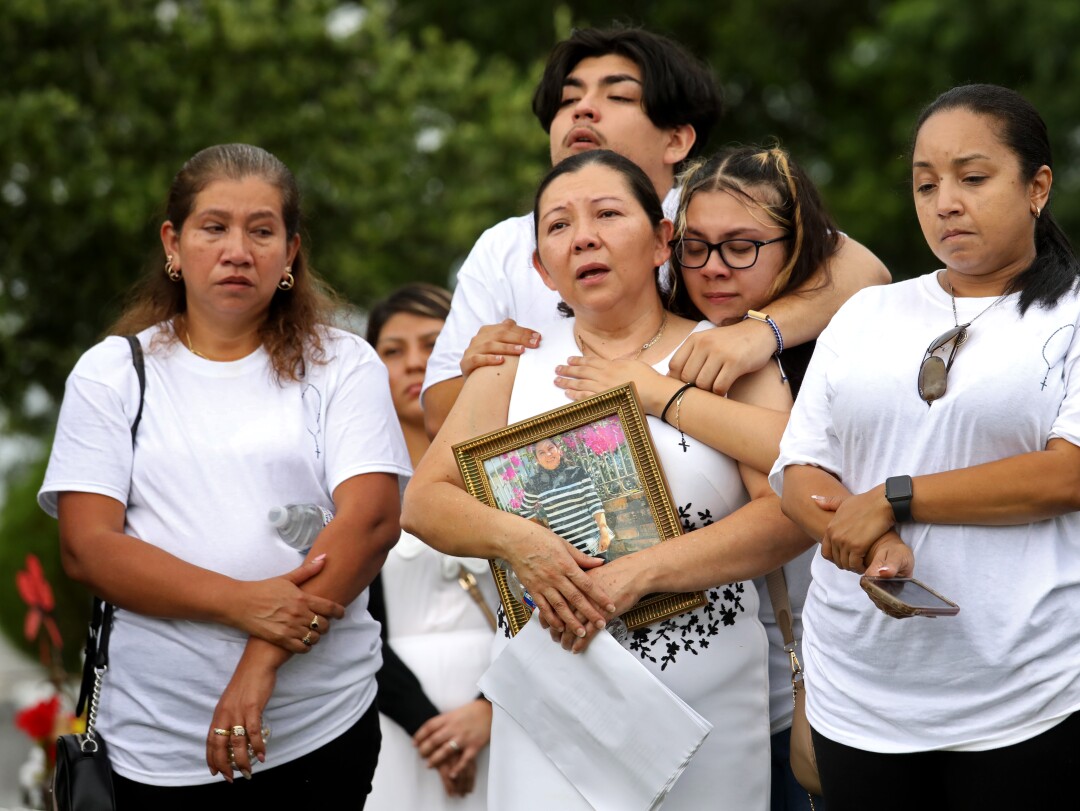 Surrounded by her children and friends, Maria Huezo, 42, holds a photograph of her sister, Rosario Yanira Girón de Orellana, 41, at Rosario’s funeral. (Gary Coronado / Los Angeles Times)
Surrounded by her children and friends, Maria Huezo, 42, holds a photograph of her sister, Rosario Yanira Girón de Orellana, 41, at Rosario’s funeral. (Gary Coronado / Los Angeles Times) The visa requests were denied. Instead, Rosario’s parents watched the funeral Mass on Facebook Live. A priest they didn’t know spoke about the daughter he had never met at a church they had never seen. Relatives wore white T-shirts embossed with black rosaries and a quote: “Today we take different paths, but I will always take with me what I learned from you.â€
By the time they reached the cemetery, a thunderstorm had rolled in. Few in the crowd of about 100 had umbrellas. But none left, not even the uniformed McDonald’s workers who had never met Rosario. Cemetery workers had to wheel over a second tent.
Adriana stood beside her mother’s grave in sneakers and a pleated black skirt. She sobbed as the casket was lowered, embracing a young uncle, one of many relatives her mother had raised. The rain stopped. The family released a white string of balloons shaped like a rosary. A guitarist played Spanish Christian pop songs, and some sang along, their voices soon drowned out by the hum of an earthmover.
They had already affixed a temporary metal plaque to the grave labeled “Rosario.†Last week, Adriana selected her mother’s headstone: gray granite, with two vases attached for her roses. It will be installed by next month, around the same time Adriana starts ninth grade.
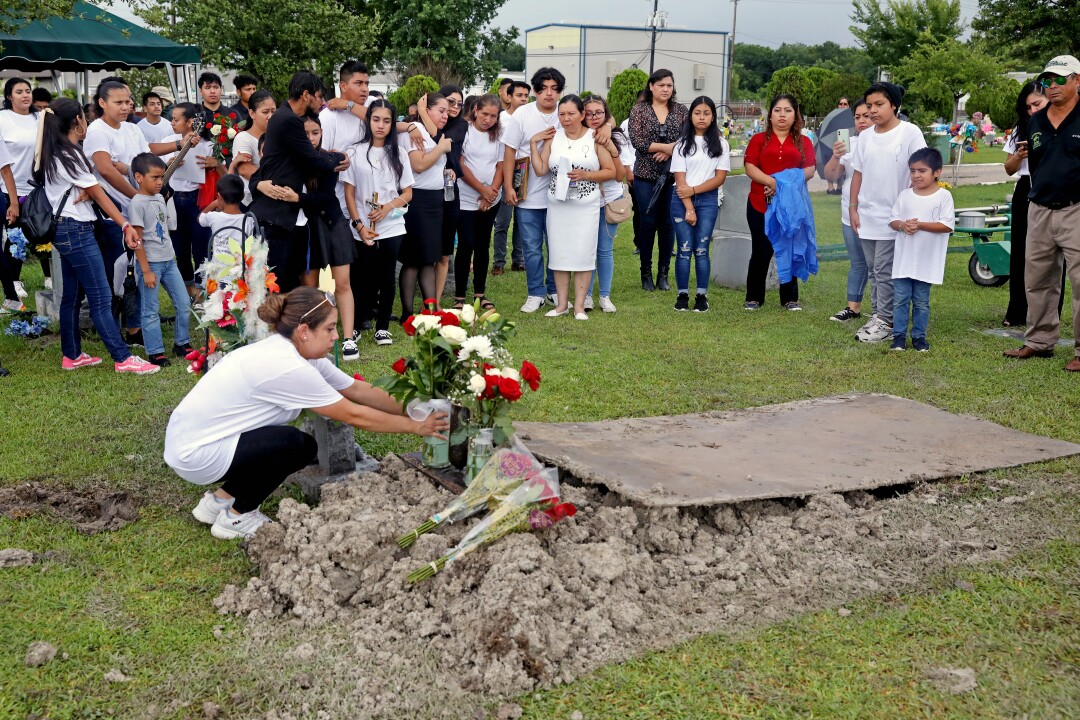 Erika Girón places flowers at the grave of her older sister Rosario Yanira Girón de Orellana.(Gary Coronado / Los Angeles Times)
Erika Girón places flowers at the grave of her older sister Rosario Yanira Girón de Orellana.(Gary Coronado / Los Angeles Times)
0 Response to "Losing Rosario A mother sent her daughter across the border Before they could reunite one died"
Post a Comment